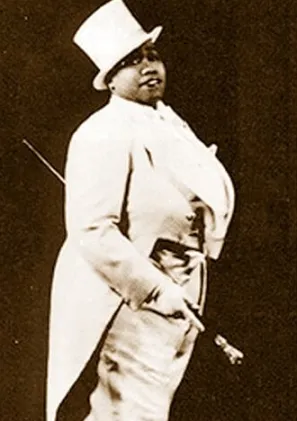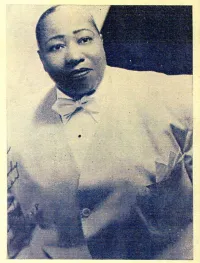Biography
1907 - 1960
“It seems I was born different. At least, I always thought I was.”
– Gladys Bentley
Born in Philadelphia in 1907, Gladys Bentley was taunted as a child for being an overweight tomboy – but in a few years she had the last laugh. In her trademark white tuxedo and top hat, the 300-pound gravelly voiced singer and piano player flaunted her reputation as a “bulldagger” or butch lesbian. A top entertainer during the Harlem Renaissance, she headlined at The Cotton Club and The Clam House where she openly flirted with the women in the audience. She took popular songs of the time – like ‘Sweet Georgia Brown’ or ‘Alice Blue Gown’ – and added suggestive lyrics in her raspy alto voice, encouraging the audience to echo the chorus. The gender-busting act was a sensation, making her one of the most beloved icons of the era. In 1928 Bentley began a 20-year recording career which sadly does not include any of her bawdy lyrics or lesbian references. Her “marriage” ceremony to a white woman in New Jersey was widely publicized, expanding the reach of notoriety, but it also quietly set her up for a life that would soon grow harsher. In the 1930s she headlined at The Ubangi Club – with a chorus of drag queens to back her – but the decade of the Great Depression would severely impact Harlem nightlife. In 1937 she moved to LA where she was harassed for wearing men’s clothing, though she managed to eke out a living working mainly in gay clubs over the next decade. The repressive climate of the 1950s made it an especially tough time to be an out butch lesbian in the U.S. Needing to salvage her career, in 1952 Bentley published an essay in Ebony saying she had been “cured” of her lesbianism and was now married to a man – though the effectiveness of her treatment and the validity of the marriage could never be verified; a sad coda to what had been a life lived without compromise. Gladys Bentley – the living embodiment of “Hot Harlem” in the 1920s – died of influenza in 1960. She was 52.
1907 - 1960
“It seems I was born different. At least, I always thought I was.”
– Gladys Bentley
Born in Philadelphia in 1907, Gladys Bentley was taunted as a child for being an overweight tomboy – but in a few years she had the last laugh. In her trademark white tuxedo and top hat, the 300-pound gravelly voiced singer and piano player flaunted her reputation as a “bulldagger” or butch lesbian. A top entertainer during the Harlem Renaissance, she headlined at The Cotton Club and The Clam House where she openly flirted with the women in the audience. She took popular songs of the time – like ‘Sweet Georgia Brown’ or ‘Alice Blue Gown’ – and added suggestive lyrics in her raspy alto voice, encouraging the audience to echo the chorus. The gender-busting act was a sensation, making her one of the most beloved icons of the era. In 1928 Bentley began a 20-year recording career which sadly does not include any of her bawdy lyrics or lesbian references. Her “marriage” ceremony to a white woman in New Jersey was widely publicized, expanding the reach of notoriety, but it also quietly set her up for a life that would soon grow harsher. In the 1930s she headlined at The Ubangi Club – with a chorus of drag queens to back her – but the decade of the Great Depression would severely impact Harlem nightlife. In 1937 she moved to LA where she was harassed for wearing men’s clothing, though she managed to eke out a living working mainly in gay clubs over the next decade. The repressive climate of the 1950s made it an especially tough time to be an out butch lesbian in the U.S. Needing to salvage her career, in 1952 Bentley published an essay in Ebony saying she had been “cured” of her lesbianism and was now married to a man – though the effectiveness of her treatment and the validity of the marriage could never be verified; a sad coda to what had been a life lived without compromise. Gladys Bentley – the living embodiment of “Hot Harlem” in the 1920s – died of influenza in 1960. She was 52.
Demography
Demography
Gender Female
Sexual Orientation Lesbian
Gender Identity Cisgender Genderqueer/Non-Binary
Ethnicity African American Black
Faith Construct Protestant
Nations Affiliated United States
Era/Epoch Harlem Renaissance (1919-1929) Jazz Age (1910-1940) Roaring Twenties (1920-1929)
Field(s) of Contribution
Entertainer
Music
Commemorations & Honors
Obituary Featured in New York Times Overlooked Series (2019)
San Francisco Rainbow Honor Walk Honoree (2022)
Demography
Gender Female
Sexual Orientation Lesbian
Gender Identity Cisgender Genderqueer/Non-Binary
Ethnicity African American Black
Faith Construct Protestant
Nations Affiliated United States
Era/Epoch Harlem Renaissance (1919-1929) Jazz Age (1910-1940) Roaring Twenties (1920-1929)
Field(s) of Contribution
Entertainer
Music
Commemorations & Honors
Obituary Featured in New York Times Overlooked Series (2019)
San Francisco Rainbow Honor Walk Honoree (2022)
Resources
Resources
Bentley, Gladys. 1952. "I am a Woman Again." Ebony (August 1952): 92-98.
Bentley, Gladys. "How Much Can I Stand." Mean Mothers: Independent Women's Blues, Vol. 1. New York: Rosetta Records (RR1300), 1992.
Chauncey, George. Gay New York: Gender, Culture, and the Making of the Gay Male World, 1890-1940. New York: Basic Books, 1994.
Faderman, Lillian. 1992. Odd Girls and Twilight Lovers: A History of Lesbian Life in Twentieth-Century America. New York: Penguin Books, 1992.
Garber, Eric. "Gladys Bentley: The Bulldagger Who Sang the Blues." OUTLook: National Lesbian & Gay Quarterly 1 (Spring 1998): 52-61.
http://en.wikipedia.org/wiki/Gladys_Bentley
https://www.nytimes.com/interactive/2019/obituaries/gladys-bentley-overlooked.html
http://www.huffingtonpost.com/irene-monroe/honoring-notorious-gladys_b_459929.html
http://msmagazine.com/blog/2012/02/21/queering-black-herstory-janelle-monae-and-gladys-bentley/
https://www.theroot.com/blues-singer-gladys-bentley-broke-ground-with-marriage-1790858771
https://www.blackpast.org/african-american-history/bentley-gladys-1907-1960/
https://www.advocate.com/women/2017/3/16/women-who-paved-way-blues-singer-gladys-bentley
Resources
Bentley, Gladys. 1952. "I am a Woman Again." Ebony (August 1952): 92-98.
Bentley, Gladys. "How Much Can I Stand." Mean Mothers: Independent Women's Blues, Vol. 1. New York: Rosetta Records (RR1300), 1992.
Chauncey, George. Gay New York: Gender, Culture, and the Making of the Gay Male World, 1890-1940. New York: Basic Books, 1994.
Faderman, Lillian. 1992. Odd Girls and Twilight Lovers: A History of Lesbian Life in Twentieth-Century America. New York: Penguin Books, 1992.
Garber, Eric. "Gladys Bentley: The Bulldagger Who Sang the Blues." OUTLook: National Lesbian & Gay Quarterly 1 (Spring 1998): 52-61.
http://en.wikipedia.org/wiki/Gladys_Bentley
https://www.nytimes.com/interactive/2019/obituaries/gladys-bentley-overlooked.html
http://www.huffingtonpost.com/irene-monroe/honoring-notorious-gladys_b_459929.html
http://msmagazine.com/blog/2012/02/21/queering-black-herstory-janelle-monae-and-gladys-bentley/
https://www.theroot.com/blues-singer-gladys-bentley-broke-ground-with-marriage-1790858771
https://www.blackpast.org/african-american-history/bentley-gladys-1907-1960/
https://www.advocate.com/women/2017/3/16/women-who-paved-way-blues-singer-gladys-bentley




